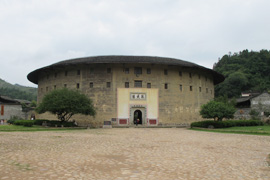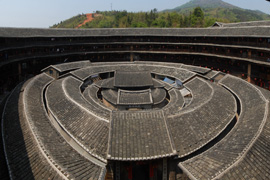|
 |
 |
|
A FORTRESS: Zhencheng Tulou, built in 1912 by descendents of a wealthy tobacco trader and dubbed "the Prince of Tulou," stands against the sky (JOSEPH HALVORSON) |
EARTHEN BUILDING: A bird's-eye view of tulou (WEI YAO) |
In the mountainous regions of southeast China lie collections of immense circular compounds, once mistakenly identified in aerial reconnaissance photographs as UFO's or missile silos. Their novel design first attracted architects, and has now found an audience among China's many tourists.
Known as "earthen buildings," or tulou in Mandarin, the fortresses are made of packed mud, sand, and clay, fortified on the inside with bamboo and wooden beams. The outer walls are up to 2 meters thick and stand at an angle toward the center to protect against earthquakes. Windows line the top floors only, allowing a rifle's aim at any bandits who dare to attempt invasion.
Centuries ago, a nomadic clan of Han, the largest ethnic group in China, who had grown tired of the dynastic wars, famine and upheaval of central China, fled south to Fujian Province. When petulant neighbors disturbed their sought-after peace around the 12th century, the group began building the innovative self-enclosed structures to protect themselves.
The original builders of tulou, the ethnic Hakka people, still speak a distinct dialect. Hakka, meaning "guest families," was a term given to the migrating clans after their ancestors settled in provincial areas such as Guangdong, Hunan and Fujian provinces. Most of the communal homes were built between the 12th and 20th century, and many have stood for hundreds of years.
In contrast to its defensive outward nature, inside the Zhencheng tulou lives a peaceful community of 14 families—70 permanent residents—where inhabitants worship the same ancestors at a central shrine. They enjoy opera performances on a stage platform flanked by banners of calligraphy with messages promoting filial piety, Taoist and Confucian ideals. "Be modest to attain success," reads one prominent display.
Residents and tourists mingle in a large courtyard, drinking tea and playing Mahjong as light rain falls through the opening above. The second floor is used for grain storage, in keeping with the community's long tradition of self-sufficiency. On the third and fourth floors are rooms that house individual families and shared kitchens.
World heritage status
The villages of Yongding County, home to as many as 20,000 tulou, are located a three-hour drive inland from the seaport city of Xiamen. A thick mist hangs over lush vegetation in the subtropical climate, where tea and tobacco fields sustain those who haven't yet made a living off the budding tourist industry.
The United Nations Educational, Scientific and Cultural Organization (UNESCO) declared a total of 46 tulou compounds as World Heritage Sites in 2008, citing them as "exceptional examples of a building tradition and function exemplifying a particular type of communal living and defensive organization in a harmonious relationship with their environment."
Those who still live in the tulou are proud of their habitat, and are quick to point out the pleasing fengshui associated with their homes, which often sit next to rivers and fertile fields. It's unclear whether the new parking lots, paved on site to support a growing numbers of tourists, clash with the area's qi (or aura).
| 